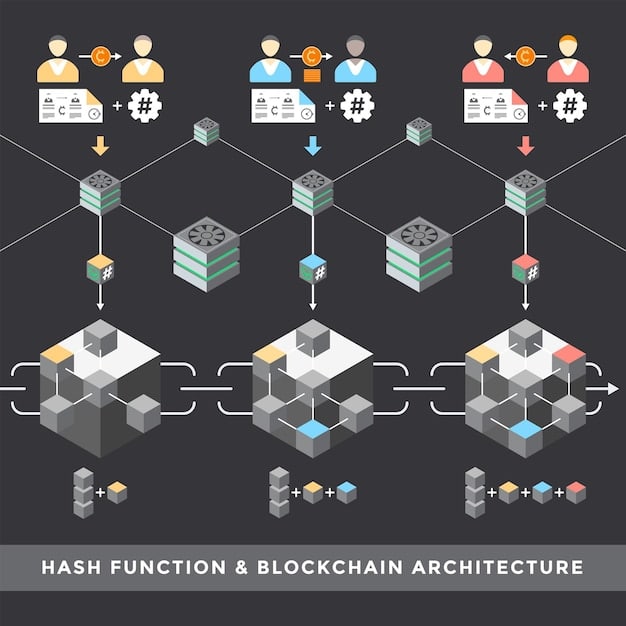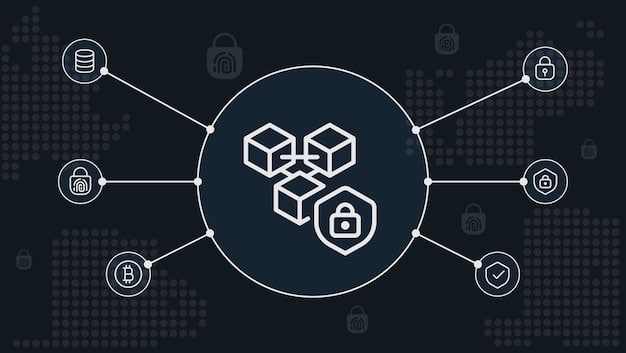Blockchain Interoperability: US Standards Impact in 2025

Blockchain Interoperability: What New US Standards Mean for Cross-Chain Transactions in 2025? addresses the evolving regulatory landscape and its implications for seamless communication and value transfer between different blockchain networks, shaping the future of decentralized finance and beyond.
Imagine a world where different blockchains can communicate and transact with each other seamlessly. This vision of Blockchain Interoperability: What New US Standards Mean for Cross-Chain Transactions in 2025? is rapidly approaching, driven by new regulations and technological advancements in the United States.
But what exactly do these new standards entail, and how will they impact the landscape of cross-chain transactions by 2025? Let’s explore what the future holds for blockchain interoperability in the US market.
Understanding Blockchain Interoperability and Its Importance
Blockchain interoperability refers to the ability of different blockchain networks to communicate, share data, and transact with each other. This is crucial because, currently, many blockchains operate in silos, limiting their functionality and potential.
The Current State of Blockchain Silos
Today, most blockchains function as isolated ecosystems. This means that assets or data on one blockchain cannot be easily transferred or used on another. This fragmentation presents significant challenges for developers, businesses, and users alike.
- Limited Scalability: Isolated blockchains can become congested, leading to slower transaction times and higher fees.
- Reduced Liquidity: Assets locked within a single blockchain cannot be easily accessed by users on other networks.
- Restricted Innovation: Developers are limited in their ability to create cross-chain applications, hindering the growth of the decentralized ecosystem.
Overcoming these limitations requires a robust framework for blockchain interoperability. This will allow for the creation of more versatile and interconnected blockchain applications.

Benefits of Interoperable Blockchains
The advantages of blockchain interoperability are numerous and far-reaching. By enabling different blockchains to work together, we can unlock new possibilities for innovation, efficiency, and accessibility.
- Enhanced Scalability: Interoperability allows for the distribution of transactions across multiple blockchains, reducing congestion and improving overall network performance.
- Increased Liquidity: Users can seamlessly move assets between different blockchains, accessing a wider range of markets and investment opportunities.
- Greater Innovation: Developers can create cross-chain applications that leverage the unique features of different blockchains, fostering innovation and creativity.
Ultimately, blockchain interoperability is essential for realizing the full potential of decentralized technology. It paves the way for a more interconnected, efficient, and accessible blockchain ecosystem.
In summary, blockchain interoperability is more than just a technical challenge; it is a fundamental requirement for the continued growth and evolution of the blockchain industry. By breaking down the barriers between different networks, we can create a more vibrant and dynamic ecosystem.
New US Standards for Blockchain Interoperability
The regulatory landscape concerning blockchain technology is evolving rapidly in the United States. New standards are being developed to address the challenges and opportunities presented by blockchain interoperability.
Overview of Emerging Regulations
Several regulatory bodies in the US have begun to explore the potential of blockchain technology and the need for standardized guidelines. These regulations aim to ensure that cross-chain transactions are secure, transparent, and compliant with existing laws.
- SEC (Securities and Exchange Commission): Focuses on the classification and regulation of digital assets, ensuring compliance with securities laws.
- CFTC (Commodity Futures Trading Commission): Oversees the trading of cryptocurrency derivatives and aims to prevent market manipulation.
- State-Level Regulations: Various states are introducing their own regulations to promote blockchain innovation while protecting consumers.
These emerging regulations collectively contribute to shaping the future of Blockchain Interoperability: What New US Standards Mean for Cross-Chain Transactions in 2025?, within the US context.
Key Provisions and Impacts
The proposed standards and regulations have several key provisions that will significantly impact cross-chain transactions. These provisions aim to establish a clear legal framework for blockchain interoperability.
- Data Privacy and Security: Emphasizing the need for robust data protection measures to safeguard user information during cross-chain transactions.
- Anti-Money Laundering (AML) Compliance: Requiring blockchain platforms to implement AML procedures to prevent illicit activities.
- Standardized Protocols: Promoting the adoption of standardized communication protocols to ensure seamless interoperability between different blockchains.
Adherence to these provisions will be crucial for blockchain platforms seeking to operate within the US market. The aim is to foster a safe and regulated environment for cross-chain transactions.
In conclusion, new US standards for blockchain interoperability are poised to create a more structured and secure environment for cross-chain transactions. These regulations will play a pivotal role in shaping the future of the blockchain industry in the US.

Technological Advancements Facilitating Interoperability
Technological advancements are playing a crucial role in enabling blockchain interoperability. These innovations are creating new possibilities for cross-chain transactions and data sharing.
Cross-Chain Technologies
Various technologies are being developed to facilitate communication and interaction between different blockchains. These cross-chain technologies are essential for achieving true interoperability.
- Atomic Swaps: Allow for the direct exchange of cryptocurrencies between different blockchains without the need for intermediaries.
- Blockchain Bridges: Act as connectors between different blockchains, enabling the transfer of assets and data.
- Relay Chains: Provide a central hub for multiple blockchains to communicate and transact with each other.
These technologies are constantly evolving, with new and innovative solutions emerging to address the challenges of blockchain interoperability.
Role of Standardized Protocols
Standardized protocols are essential for ensuring that different blockchains can communicate and interact with each other seamlessly. These protocols define the rules and procedures for cross-chain transactions.
The development and adoption of standardized protocols can significantly enhance blockchain interoperability. This involves defining common formats for data and transactions, as well as establishing clear guidelines for communication between different networks.
In recap, technological advancements are driving the progress of blockchain interoperability. Cross-chain technologies and standardized protocols are essential components of this evolution, paving the way for a more interconnected and versatile blockchain ecosystem.
Impact on Cross-Chain Transactions by 2025
By 2025, the impact of new US standards on cross-chain transactions is expected to be substantial. These standards will shape the future of decentralized finance (DeFi) and other blockchain applications.
Expected Changes in Transaction Speed and Cost
One of the primary impacts of blockchain interoperability will be the improvement in transaction speed and cost. By enabling seamless communication between different blockchains, cross-chain transactions are expected to become faster and more efficient.
Moreover, standardized protocols and cross-chain technologies will help reduce the cost of transactions. This will make it more affordable for individuals and businesses to participate in the blockchain ecosystem.
Implications for DeFi and Beyond
Blockchain interoperability will have far-reaching implications for DeFi and other blockchain applications. Cross-chain functionality will enable the creation of new and innovative financial products and services.
For example, users will be able to seamlessly move assets between different DeFi platforms, accessing a wider range of investment opportunities. This will enhance liquidity and efficiency in the DeFi ecosystem.
To summarize, the new standards and technological advancements are expected to transform cross-chain transactions by 2025. The improvements in transaction speed, cost, and functionality will drive the growth and adoption of blockchain technology across various industries.
Challenges and Opportunities Ahead
Despite the progress being made in blockchain interoperability, several challenges and opportunities still lie ahead. Addressing these issues will be crucial for realizing the full potential of cross-chain transactions.
Addressing Security Concerns
Security remains a primary concern in the context of blockchain interoperability. Cross-chain transactions can introduce new vulnerabilities and attack vectors. Ensuring the security of these transactions is essential for maintaining trust in the blockchain ecosystem.
Developing robust security protocols and conducting thorough audits are critical steps in mitigating these risks. As the technology matures, it will be necessary to stay ahead of potential threats and vulnerabilities.
Opportunities for Innovation and Growth
Despite the challenges, blockchain interoperability presents numerous opportunities for innovation and growth. Cross-chain functionality can unlock new possibilities for businesses and developers, fostering creativity and collaboration.
Encouraging innovation through sandboxes and regulatory clarity can play a significant role in maximizing these opportunities. The exploration of use cases for interoperable blockchains will drive the industry forward.
In conclusion, while blockchain interoperability faces challenges such as security concerns, it also presents significant opportunities for innovation and growth. Overcoming these challenges and capitalizing on these opportunities will be essential for shaping the future of blockchain technology. The journey toward achieving seamless cross-chain transactions requires collaboration, innovation, and a commitment to security.
| Key Point | Brief Description |
|---|---|
| 🔗 Interoperability | Enables blockchains to communicate and transact with each other. |
| ⚖️ US Standards | New regulations aim to secure and standardize cross-chain transactions. |
| 🚀 Cross-Chain Tech | Atomic swaps, bridges, and relay chains facilitate interoperability. |
| 💰 DeFi Impact | Enhanced liquidity and new financial products emerge with interoperability. |
FAQ
It refers to the ability of different blockchain networks to seamlessly communicate, share data, and transact with each other, which is essential for a more interconnected blockchain ecosystem. New US standards influence this future.
Blockchain interoperability unlocks increased scalability, enhanced liquidity, and greater innovation by allowing different blockchain networks to work together. This promotes a more versatile and dynamic ecosystem.
Key technologies include atomic swaps, blockchain bridges, and relay chains. These technologies enable the transfer of assets and data between different blockchain networks, facilitating seamless cross-chain transactions.
New US regulations aim to provide a clear legal framework for blockchain interoperability, focusing on data privacy, security, and AML compliance. This will foster a safer and more regulated environment.
Potential challenges include addressing security concerns and ensuring regulatory compliance. Overcoming these challenges is essential for realizing the full potential of Blockchain Interoperability: What New US Standards Mean for Cross-Chain Transactions in 2025?
Conclusion
In conclusion, Blockchain Interoperability: What New US Standards Mean for Cross-Chain Transactions in 2025? represents a significant step toward a more connected and efficient blockchain ecosystem. The new US standards and technological advancements are poised to transform cross-chain transactions, enhancing functionality, security, and accessibility.
As the blockchain industry continues to evolve, embracing interoperability will be crucial for unlocking the full potential of decentralized technology. By addressing the challenges and capitalizing on the opportunities, we can create a more vibrant and interconnected blockchain ecosystem, paving the way for a future of seamless cross-chain transactions.





